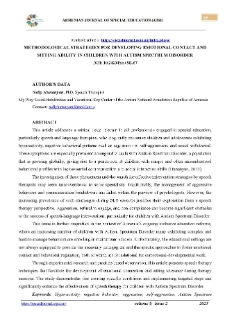Նիւթ
Վերնագիր: Methodological Strategies For Developing Emotional Contact And Sitting Ability In Children With Autism Spectrum Disorder
Ամսագրի կամ հրապարակման վերնագիր:
Հրապարակման ամսաթիւ:
Հատոր:
Համար:
ISSN:
Պաշտոնական URL:
Համատեղ հեղինակները:
Խաչատուր Աբովյանի անվան հայկական պետական մանկավարժական համալսարան
Ծածկոյթ:
Ամփոփում:
This article addresses a critical issue relevant to all professionals engaged in special education, particularly speech and language therapists, who frequently encounter children and adolescents exhibiting hyperactivity, negative behavioral patterns such as aggression or self-aggression, and social withdrawal. These symptoms are especially prevalent among individuals with Autism Spectrum Disorder, a population that is growing globally, giving rise to a generation of children with unique and often misunderstood behavioral profiles who lack essential communication and social interaction skills (Hunanyan, 2013). The investigation of these phenomena and the search for effective intervention strategies by speech therapists may seem unconventional to some specialists. Traditionally, the management of aggressive behaviors and communication breakdowns has fallen within the purview of psychologists. However, the increasing prevalence of such challenges during SLT sessions justifies their exploration from a speech therapy perspective. Aggression, refusal to engage, and non-compliance can become significant obstacles to the success of speech-language interventions, particularly for children with Autism Spectrum Disorder. This issue is further magnified in the context of Armenia’s ongoing inclusive education reforms, where an increasing number of children with Autism Spectrum Disorder many exhibiting complex and hard-to-manage behaviors are enrolling in mainstream schools. Unfortunately, the educational settings are not always equipped to provide the necessary pedagogical and therapeutic approaches to foster emotional contact and behavioral regulation, both of which are foundational for correctional-developmental work. Through experimental research and practice-based observation, this article presents speech therapy techniques that facilitate the development of emotional connection and sitting tolerance during therapy sessions. The study demonstrates that creating specific conditions and implementing targeted steps can significantly enhance the effectiveness of speech therapy for children with Autism Spectrum Disorder.
Հրատարակութեան վայրը:
Երևան
Ձեւաչափ:
Նոյնացուցիչ:
oai:arar.sci.am:421713
Նիւթին հաւաքածոները:
Վերջին անգամ ձեւափոխուած է:
Oct 30, 2025
Մեր գրադարանին մէջ է սկսեալ:
Oct 29, 2025
Նիւթին բովանդակութեան հարուածներուն քանակը:
6
Նիւթին բոլոր հասանելի տարբերակները:
https://arar.sci.am/publication/454107
Ցոյց տուր նկարագրութիւնը RDF ձեւաչափով:
Ցոյց տուր նկարագրութիւնը OAI-PMH ձեւաչափով։
-
Հատուկ կրթության հայկական ամսագիր=Проблемы специального образования=Armenian Journal of Special Education
-
Armenian Journal of Special Education, 2014, vol. 1, 1
-
Armenian Journal of Special Education, 2014, vol. 1, 2
-
Armenian Journal of Special Education, 2015, vol. 2, 1
-
Armenian Journal of Special Education, 2016, vol. 3, 1
-
Armenian Journal of Special Education, 2017, vol. 3, 2
-
Armenian Journal of Special Education, 2020, vol. 4, 1
-
Armenian Journal of Special Education, 2020, vol. 4, 2
-
Armenian Journal of Special Education, 2021, vol. 5, 1
-
Armenian Journal of Special Education, 2021, vol. 5, 2
-
Armenian Journal of Special Education, 2022, vol. 6, 1
-
Armenian Journal of Special Education, 2022, vol. 6, 2
-
Armenian Journal of Special Education, 2023, vol. 7, 1
-
Armenian Journal of Special Education, 2024, vol. 8, 1
-
Armenian Journal of Special Education, 2024, vol. 8, 2
-
Armenian Journal of Special Education, 2025, vol. 9, 1
-
Armenian Journal of Special Education, 2025, vol. 9, 2
- Editorial board
- Message Of The Editorial Board Chairman
- Content
- Connected Speech Development Patterns In Preschool-Aged Children
- Chess In Inclusive Education
- Macedonian Early Childhood Intervention: Challenges And Opportunities
- School Bullying As A Contributor To Students’ Mental Health Issues
- Readiness Of University Students In Special Education To Work With Pupils With Special Educational Needs In The Inclusive Education System
- Methodological Strategies For Developing Emotional Contact And Sitting Ability In Children With Autism Spectrum Disorder
- An Integrated Pedagogical System Of Career Guidance With Students
- Methods To Enhance Speech Pathologists’ Professional Qualifications In Collaborative Work
- Addressing Speech Disorders: A Quick Review And Description
-
Armenian Journal of Special Education, 2014, vol. 1, 1
| Հրատարակութեան անունը | Թուական |
|---|---|
| Hunanyan, Nelly, Methodological Strategies For Developing Emotional Contact And Sitting Ability In Children With Autism Spectrum Disorder | Oct 30, 2025 |





